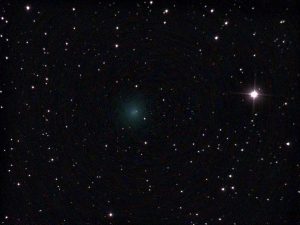A rather splendid image of Comet C/2023 E1 (ATLAS) taken by CMHASD trustee and secretary Dr. Mike Rushton on the 12/13th July 2023 in Ursa Minor.
Mike wrote ”This is C/2023 E1 (ATLAS) last night. Approx Mag 14.5 with a greenish coma. The bright star in the image is Mag 7 and the limiting Mag 17.5. Perihelion was 1/7/23 and closest to earth will be on 18/8/23. This was a 20 min exposure with my eVscope.” Imaging started just before midnight on 12/7/23 (23:57 BST).

Comet C/2023 E1 (ATLAS) was spotted on the 1st March 2023 by the NASA funded Asteroid Terrestrial-impact Last Alert System (ATLAS). At the time, the comet was a +19th magnitude object moving through the constellation of Virgo.
On July 1 this Comet ATLAS reached perihelion, its closest approach to the Sun.
To date the comet has now moved into Draco and will move into Cepheus towards its closest approach to Earth mid-August. On August 18 this visitor to the inner Solar System will only be 3 light-minutes or so from our planet.
Based on its inclination to the ecliptic plane (38 degree) and orbital period of about 85 years C/2023 E1 (ATLAS) is considered a Halley-type comet. Though the comet currently has a ‘C’ designation for a long period comet versus periodic comet; that will probably change as 85 years is much less than the 200 year orbital period cut off defining the 2 categories of comet.
Below is the report from SETI/UNISTELLAR Mike received back after submitting his imaging data.
Mike said ”I have had the photometry back and it was brighter than I thought at Mag 12.8. See the report from seti below. The little image in that report is stacked on the moving comet. The original image I sent was stacked on the stars.”

For more information: https://www.space.com/comet-c2023-e1-atlas-little-dipper-how-to-see
